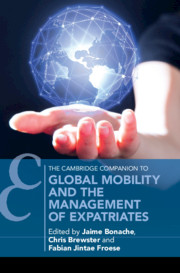Book contents
- Global Mobility and the Management of Expatriates
- Cambridge Companions to Management
- Global Mobility and the Management of Expatriates
- Copyright page
- Contents
- Figures
- Tables
- Contributors
- 1 Global Mobility
- Part I The Expatriation Process of Corporate Expatriates
- Part II Different Types of Expatriates and Stakeholders
- 7 Short-term Assignees, International Business Travellers, and International Commuters
- 8 Self-initiated Expatriates
- 9 Skilled Migrant Careers
- 10 Women and Global Mobility
- 11 Global Families
- 12 Roles and Challenges for Global Mobility Departments
- Index
- References
12 - Roles and Challenges for Global Mobility Departments
from Part II - Different Types of Expatriates and Stakeholders
Published online by Cambridge University Press: 12 November 2020
- Global Mobility and the Management of Expatriates
- Cambridge Companions to Management
- Global Mobility and the Management of Expatriates
- Copyright page
- Contents
- Figures
- Tables
- Contributors
- 1 Global Mobility
- Part I The Expatriation Process of Corporate Expatriates
- Part II Different Types of Expatriates and Stakeholders
- 7 Short-term Assignees, International Business Travellers, and International Commuters
- 8 Self-initiated Expatriates
- 9 Skilled Migrant Careers
- 10 Women and Global Mobility
- 11 Global Families
- 12 Roles and Challenges for Global Mobility Departments
- Index
- References
Summary
This chapter addresses the following questions: Why and how do we need to rethink GM to enable it to master its future? What roles do GM professionals enact to refine their work and to make working abroad more attractive? Overall, this chapter explores the pressures that GM professionals are facing, provides insights into the roles of GM departments and develops a refined GM model. Notwithstanding some of the limitations that diverse contexts, diverging managerial objectives, lacking GM capabilities, and implementation difficulties present, it can be argued that smart, agile, flawless, and efficient GM work (SAFE GM) is at the core of a successful GM department. Smart organisational development and talent management; agile approaches to embrace a multitude of GM challenges successfully; flawless design of programme management and compliance approaches; and efficient ways to structure GM rewards, are leading to a professionalisation of global mobility work. Enacting this SAFE GM framework is likely to strengthen the position of GM departments in their organisation, making their work more strategic, operationally focussed and important.
Keywords
- Type
- Chapter
- Information
- Global Mobility and the Management of Expatriates , pp. 289 - 314Publisher: Cambridge University PressPrint publication year: 2020

